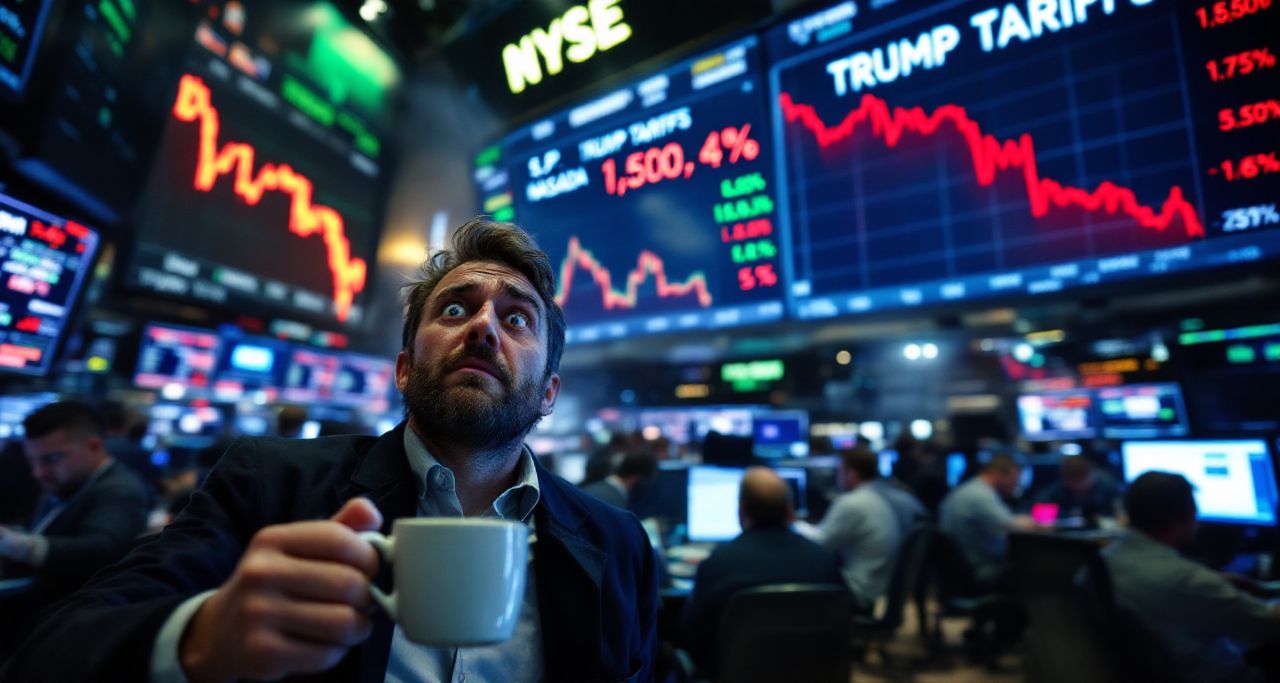
The financial world reeled Thursday as President Donald Trump unleashed what many are calling a nuclear bomb on global trade, sending markets into their worst tailspin since the pandemic.
His sweeping tariff announcement – imposing at least 10% on all imports with steeper rates for China and European Union goods – triggered a massive sell-off that rippled through every major exchange worldwide.
By midday, Wall Street was bleeding red. The S&P 500 plummeted 4%, the Dow Jones hemorrhaged over 1,500 points, and the tech-heavy Nasdaq collapsed more than 5%. Small companies took the worst beating, with the Russell 2000 crashing into bear territory after shedding over 6%.
“I’ve never seen anything like this,” muttered a shell-shocked trader on the NYSE floor, coffee spilling from his trembling cup. “It’s 2020 all over again, but this time it’s man-made.”
The carnage wasn’t confined to American shores. European markets crumbled, with France’s CAC 40 and Germany’s DAX tumbling over 3%. Asian markets had already taken their lumps, Japan’s Nikkei 225 dropping 2.8% while Hong Kong and Seoul markets also posted significant losses.
“Trump promised ‘Liberation Day,’ but this feels more like Doomsday for global trade,” said Maria Gonzalez, chief economist at Meridian Capital. “The market had priced in some tariffs, but nobody expected this sledgehammer approach.”
Economic Fallout: The Specter of Stagflation
The tariffs, which Trump framed as a strategy to bring manufacturing jobs back to the U.S., have raised the dreaded specter of stagflation – a toxic combination of high inflation and stagnant economic growth that plagued the 1970s. Economists at UBS estimate the tariffs could shave 2 percentage points off U.S. GDP growth this year while pushing inflation close to 5%.
“Markets may actually be underreacting,” warned Sean Sun of Thornburg Investment Management. “If these tariffs stick, the knock-on effects to global consumption and trade could be far worse than what we’re seeing now. It’s like using a flamethrower to light a birthday candle.”
At Best Buy, where stock plunged 15%, employees whispered anxiously about what Chinese-made electronics would soon cost. Target shares nosedived nearly 12% as analysts calculated how much more shoppers would pay for everyday items. United Airlines stock crashed 13% as investors envisioned Americans canceling vacation plans they could no longer afford.
“My retirement account just lost six figures,” lamented Sandra Wilkins, 58, a school administrator from Denver. “I was planning to retire next year. Now who knows?”
The Fed’s Impossible Position
The Federal Reserve finds itself trapped in an economic vice. Cut rates to stimulate the economy, and risk fueling inflation already being stoked by tariffs. Hold steady, and watch growth potentially collapse.
“Powell is damned either way,” said veteran market watcher Tom Jenkins. “This is like trying to perform surgery during an earthquake.”
Treasury yields tumbled on rising expectations for rate cuts, with the 10-year yield plunging to 4.02% from 4.20% – a massive move for the typically stable bond market. But the Fed’s freedom to maneuver may be severely constrained by the inflationary pressures the tariffs will create.
Global Trade War Looms
The announcement has heightened fears of a broader trade war that could further destabilize the global economy. Countries targeted by the tariffs have already signaled their intent to retaliate, with the European Commission convening an emergency session and Chinese officials warning of “proportional responses.”
“We’re watching the first dominoes fall in what could become a global trade war,” warned former Treasury Secretary Lawrence Summers. “History teaches us nobody wins these conflicts.”
On factory floors across America, reactions were mixed. At Heartland Steel in Ohio, workers celebrated. “Finally someone’s standing up for American manufacturing,” said foreman Rick Delaney. But at nearby Midwest Electronics, which relies on imported components, the mood was grim. “If parts prices jump 25%, we’re finished,” said CEO Ellen Marsh.
The Political Calculus
While the tariffs align with Trump’s long-standing “America First” agenda, they represent a significant economic gamble. The president has framed the measures as necessary medicine for an ailing economy.
“For decades, other countries have taken advantage of America,” he told supporters at a Pennsylvania rally Thursday evening. “Those days are over.”
But many economists disagree with both the diagnosis and prescription. “Tariffs are taxes paid by American consumers and businesses,” explained Georgetown economics professor James Wilson. “The idea that they’ll bring manufacturing jobs back overnight is fantasy. What they will bring is higher prices at Walmart next week.”
Mary Ann Bartels, chief investment officer at Sanctuary Wealth, put it bluntly: “Trump is using tariffs as a blunt instrument to achieve a political goal. But the economic costs could be devastating, both domestically and globally.”
As trading floors emptied Thursday evening, the question on everyone’s lips was whether this represents just an opening gambit in a high-stakes negotiation, or Trump’s actual economic policy. Either way, the global economy has entered a period of heightened uncertainty, with the potential for significant disruption in the months ahead.
For now, markets remain in turmoil, and millions of Americans are left wondering what their next shopping trip – or retirement account statement – will look like in this new economic landscape.
